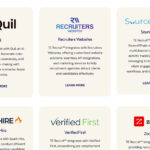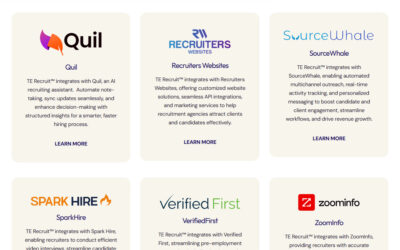In the past decade, social media has become an integral part of our daily lives. For many, platforms like Facebook, Twitter, LinkedIn, Instagram, and others are not just a way to stay connected with friends and family, but also a tool to explore career opportunities. Often, people interact with others through these platforms rather than in-person or over the phone. This shift toward digital communication is one of the reasons why social media has become such a powerful tool for recruiters.
The ability to efficiently source, connect with, and screen potential candidates has made social media an invaluable resource for hiring professionals. According to BetterTeam, 94% of professional recruiters use at least one social media platform to engage with candidates. But while many recruiters are familiar with these platforms, knowing how to use them effectively is key to building relationships with both active and passive candidates.
In this article from Top Echelon Recruiting Software, we’ll explore how to source candidates in social media in the Digital Age.
The Benefits of Incorporating Social Media into Your Recruiting Strategy
Social media has become an essential recruiting tool, and its reach is unmatched. In the U.S. alone, there are approximately 250 million active social media users, and they spend an average of 135 minutes per day on these platforms, according to Statista. With so many people actively engaging online, it’s no wonder that 92% of recruiters utilize social media as part of their talent acquisition strategy, as reported by Jobvite’s Recruiter Nation Survey. Here are some of the key benefits of using social media for recruiting:
1. Increased Job Visibility
Nearly half of all job seekers in the U.S. used social media to find their most recent job, according to Jobvite’s Job Seeker Nation Study. For recruiters, this means there’s a vast pool of potential candidates actively seeking jobs through these platforms. Posting job openings and engaging with potential candidates on social media increases your job visibility, helping you reach a broader audience than traditional job boards alone.
This visibility also extends to passive candidates—those who may not be actively searching for a new job but are open to new opportunities. By sharing engaging content and showcasing your company culture, you can attract the attention of these passive candidates, who may not be reachable through more conventional recruiting channels.
2. Narrowing Your Search
Social media allows recruiters to target specific candidates based on granular details such as location, education, work history, and skill set. Whether you’re looking for a specialist in a niche industry or someone with a broad skill set, platforms like LinkedIn and Facebook allow for precise candidate targeting. This enables you to narrow your search and focus on the most qualified candidates for the job.
For instance, LinkedIn’s advanced search features allow you to filter candidates based on years of experience, industry, and even specific certifications, making it easier to find the ideal fit for a position. Similarly, Facebook’s search tools can help you hone in on specific candidates based on location, interests, and job history.
3. Gaining Insight into Potential Candidates
One of the advantages of social media is the transparency it provides into a candidate’s background and behavior. Recruiters can look beyond a candidate’s resume to gain insight into their communication skills, temperament, industry involvement, and professional achievements. Platforms like LinkedIn give you a glimpse of a candidate’s work experience and connections, while Twitter and Facebook provide a more candid look at their interests and personality.
This level of insight allows recruiters to craft more personalized messages when reaching out to candidates. By demonstrating that you’ve taken the time to understand their background and experience, you’re more likely to build rapport and engage them in meaningful conversations about potential opportunities.
4. Connecting with Passive Candidates
Passive candidates, who make up 70% of the workforce according to LinkedIn, are not actively seeking new opportunities but are open to hearing about them. Social media provides an excellent avenue for connecting with these individuals in a non-intrusive way. By engaging with their content, sharing relevant job postings, and showcasing your employer brand, you can pique their interest and build relationships over time.
Unlike direct recruitment methods, social media allows for a more casual approach, which can be particularly effective when dealing with passive candidates. A personalized message on LinkedIn or a thoughtful comment on their Twitter feed can open the door to future conversations about career opportunities.
Most Popular Social Media Platforms for Recruiting
While many social media platforms can be used for recruitment, some are more effective than others, depending on the type of candidates you’re looking for. Let’s explore how to leverage three of the most popular platforms for sourcing and engaging candidates.
LinkedIn: The Professional Network
Since its launch in 2003, LinkedIn has evolved into the go-to platform for both job seekers and recruiters. With over 154 million users in the U.S., including half of all college graduates, LinkedIn is a treasure trove of talent for recruiters. According to Pew Research Center, 94% of recruiters use LinkedIn to post jobs, build professional connections, and engage with candidates.
Here’s how to maximize your recruiting efforts on LinkedIn:
- Write Accurate and Descriptive Job Listings: Job descriptions should be concise yet informative. Ideally, they should fall between 700 and 2,000 words, as job postings within this range tend to receive 30% more applications, according to Indeed.
- Leverage Advanced Search: LinkedIn’s advanced search allows you to filter candidates by specific parameters like industry, years of experience, and seniority level. For even more refined results, use Boolean operators to combine or exclude terms in your search queries.
- Participate in LinkedIn Groups: Join industry-specific LinkedIn groups to engage with professionals who possess the skills and experience you’re looking for. Actively contribute to discussions, ask questions, and share industry news. Regular participation helps you establish credibility and expand your network of potential candidates.
- Use Sponsored Jobs: LinkedIn’s Sponsored Jobs feature allows you to promote your job postings to a targeted audience. Even candidates who aren’t actively looking for a job will see your listings if they match your criteria.
Facebook: The Largest Social Network
With nearly 2 billion active users worldwide, Facebook remains one of the most popular platforms for social recruiting. Here’s how to use Facebook effectively for recruitment:
- Conduct Granular Searches: Facebook’s search function allows recruiters to filter candidates based on location, profession, education, and more. To refine your search, consider using Boolean operators to further narrow down your list of potential candidates.
- Create Engaging Job Posts: Traditional job listings can appear out of place on Facebook. Instead, create an engaging “elevator pitch” that highlights both the job responsibilities and the company culture. Be sure to include images or videos in your posts, as content with visual elements receives 94% more views, according to Pew Research Center.
- Promote Job Openings through Facebook Ads: With Facebook Ads Manager, you can promote job postings to a highly targeted audience based on demographics, location, education, and interests. You can also create custom audiences by importing your contact list.
- Engage with Candidates through Facebook Messenger: Use Messenger to communicate with candidates in real-time. A quick chat via Messenger can help you gauge a candidate’s interest and availability before scheduling a formal interview.
Twitter: Engaging the Highly Active User Base
Twitter may be underused by recruiters, but the platform boasts a highly engaged audience. Users on Twitter are 31% more likely to remember something they read or saw on the platform, according to Twitter’s own research. Here’s how to use Twitter for recruiting:
- Use Twitter’s Advanced Search: Twitter’s search features allow you to filter candidates by location, keywords, and hashtags. You can even track specific users’ tweets to gain better insight into their expertise and interests.
- Create Sourcing Lists: A Twitter list allows you to group specific users so that you can monitor their tweets. Private lists are useful for tracking potential candidates, while public lists can help you engage with professionals in your industry.
- Hashtag Effectively: Use relevant hashtags to categorize your job posts and make them more discoverable. For example, you can use industry-specific hashtags like #TechJobs or location-based hashtags like #NYCJobs. Keep your posts concise and engaging, as you only have 280 characters.
- Engage Consistently: Tweet three to five times a day, and mix in job-related content with industry news, tips, and insights. Consistent engagement helps establish your presence and builds trust with potential candidates.
How to Source Passive Candidates on Social Media
Sourcing passive candidates—those not actively seeking new jobs—requires a thoughtful approach. Here’s how to tailor your strategy for each platform:
- LinkedIn: Rather than sending a connection request right away, use LinkedIn as a research tool. Find passive candidates, then use a contact data provider to collect their email or phone number. When reaching out, keep the message short, emphasize your client’s company culture, and make it clear you’re available to discuss the opportunity at their convenience.
- Facebook: While Facebook isn’t always the best platform for direct outreach, it can be useful for researching candidates. If you do decide to contact someone via Facebook, acknowledge that the platform isn’t typically used for professional outreach and highlight why you believe they’d be a great fit for the role.
- Twitter: Twitter can be a challenge when it comes to sourcing passive candidates, but with the right strategy, it’s possible. Start by building a complete profile that includes a professional bio, a clear photo, and your email address. Engage with industry hashtags and join conversations to build rapport.
How an ATS Can Help You Source on Social Media
Even with the best strategies, manually sourcing candidates on social media can be time-consuming. That’s where an Applicant Tracking System (ATS) can help. A robust ATS offers features like browser extensions to import social profiles, data enrichment to gather additional candidate information, and automated job posting to social media.
Some ATS systems also include meeting schedulers, allowing candidates to book appointments with you directly, further streamlining the recruitment process.
Conclusion: Social Media as a Recruitment Tool
With nearly 3 billion social media users worldwide, platforms like LinkedIn, Facebook, and Twitter offer a massive pool of potential candidates for recruiters. By leveraging the unique features of each platform and incorporating tools like an ATS, recruiters can streamline the hiring process, engage with both active and passive candidates, and fill positions more efficiently.
The key to success lies in understanding the psychology of each platform, engaging consistently, and creating compelling job postings that resonate with your target audience. In today’s digital age, a simple tweet, post, or comment can be the difference between finding the perfect candidate or missing out.








